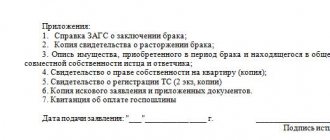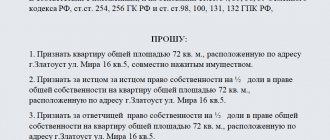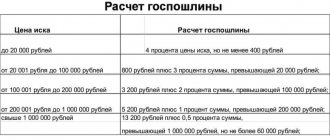During the process of entering into an inheritance, a notary may refuse to issue a certificate in respect of some objects and recommend filing a claim with the court to include the property in the inheritance mass. This need arises when the testator’s ownership of the thing cannot be confirmed with documents. That is, when such documents are missing, compiled incorrectly, or contain errors. For example, a non-privatized apartment, a summer cottage or a plot of land, the ownership of which is not registered in the state register of rights.
When entering into an inheritance, documents regarding the property are provided both by the heirs and requested by the notary who conducts the inheritance case. The court's decision on the claim for inclusion of property in the inheritance mass will become the basis for taking the object into account as part of the inheritance and dividing it between the heirs or recognizing the right of ownership in the order of inheritance. For your convenience, we have posted an example of such a claim. If you have any difficulties, you can use the help of the site’s on-duty lawyer.
:
Statement of claim for inclusion of property in the inheritance estate
Inclusion in the hereditary mass
In accordance with Art. 1112 of the Civil Code of the Russian Federation, the inheritance mass includes:
- all movable and immovable property of the deceased;
- funds in bank accounts;
- copyright and other related rights;
- shares and securities;
- debts and obligations of the testator.
Property obligations that are personal in nature do not apply to inherited property. These are alimony, fines, amounts to compensate for harm to the life and health of other citizens.
The process of including property in the estate:
- The heir submits an application to the notary.
- The assignee collects title documents for each property of the deceased.
- The notary creates a list of inherited property.
Important! Successors can only receive ownership of the property that was properly included in the inheritance property.
However, some properties owned by the deceased may not be included in the estate. This is a municipal apartment in which the testator lived, but did not have time to complete the privatization process. Or a plot of land given to him for a dacha, which he constantly used, but did not have time to register.
Spousal share of inheritance
The estate also includes the marital share. This is part of the joint property of the deceased and his spouse.
During marriage, husband and wife acquire property. They are subject to the regime of jointly acquired property.
Spouses can divide such property during marriage (nuptial agreement, agreement). If this is not done, then the surviving spouse's share must be allocated. And the testator’s share is included in the inheritance.
To allocate a share you must:
- Contact the notary office at the place where the inheritance was opened.
- Submit an application for the allocation of the spousal share.
- Pay the state fee.
- Claim your rights to a share in the inherited property as an heir.
Note! If the surviving spouse does not apply for the allocation of the marital share, then it is included in the inheritance.
State fee for filing a claim
To consider any property issue, it becomes necessary to pay a state contribution or duty. The amount of the contribution directly depends on the estimated value of the property. The size can vary from two hundred rubles to twenty thousand.
We recommend reading: Is it necessary to enter into an inheritance if there is a deed of gift?
It is possible to document the cost with cadastral documents, an examination report, inventory paper, and bank statements. The size must be determined accurately. There is no need to distort data. If a violation is detected, it is possible for the court to refuse to recognize the right of ownership. Failure to pay the fee will cause recognition of rights. It is very important to prepare all the necessary papers. This is a prerequisite for obtaining a positive decision.
Defendant in trial
The defendant in the process is the administration of the district on whose territory the property is located.
Often, property that is not included in the inheritance mass is a municipal apartment (which was not privatized by the testator) or a plot of land (issued for use and not officially registered).
Even if the objects are located in the territory where the testator was registered, the application is submitted at the location of the property.
Statement of claim for recognition of property rights by inheritance
How to refuse an inheritance after 6 months? Step by step order
Grounds for refusal to accept an application
In addition to the interests of the testator whose property rights are infringed, one can consider the reimbursement of funds under the loan agreement to the deceased, determining the share of payment by all heirs.
The claim is not always granted. There are a number of errors that can cause a failure:
- Wrong choice of judicial body;
- Making a decision earlier;
- The plaintiff withdrew the application;
- Failure to pay state duty.
Refusal is notified within five days. A repeated application will not be accepted for consideration. The judicial authority has the right to stop the consideration of the case if the package of documents is incomplete or there are errors in filing the claim. After correcting all the shortcomings, the process is resumed. The wrong choice of a judicial authority will cause failure and the impossibility of drawing up a repeated appeal.
Procedure for going to court
The procedure for including property in the inheritance includes:
- Collection of evidence.
- Preparing a claim.
- Payment of duty.
- Going to court.
- Obtaining a court decision.
- Applying to a notary to issue a certificate.
Important! A better option is to include property in the estate and at the same time recognize ownership of it. Otherwise, you will have to contact a notary and pay an additional fee.
Deadlines for filing a claim
You can go to court with a claim for inclusion in the estate only within 6 months from the date of opening of the inheritance. If this period has expired, the applicant must apply to the court for recognition of ownership rights.
Don't hesitate to submit your application. If the period expires, the applicant will need to go to court to restore the period. But the court does not always agree to an extension. Therefore, the heir may lose his share.
Important! Often, the court takes into account the actual acceptance of the inheritance, even if it is necessary to additionally include property in the inheritance mass.
Thus, the person who has actually assumed the rights has the right to receive property that was not initially included in the inheritance.
Jurisdiction
The application is submitted to the district court.
Depending on the property, the claim is sent to:
- to the court at the location of the property (for real estate);
- to the court at the place where the inheritance was opened (for movable property, accounts, shares).
Example. The Ilyinas opened a bank account in the name of their wife and saved money on it. The husband died. The widow and daughter from her first marriage acted as heirs. The girl had to go to court to include ½ share of the funds in the account as part of the inheritance.
Collection of documents
An appeal to the court is necessary if the heir does not have title documents for the property. However, he must prove that the testator used the property lawfully.
Sample list of documents:
- passport;
- documents on inheritance rights (kinship or will);
- resolution on transfer of the object for use;
- social tenancy agreement for an apartment and warrant;
- evidence that the testator wanted to register ownership of the property, but did not have time.
Required documents
The documents needed to prepare a claim, proof of ownership, are varied. The person filing the claim must be an heir by law and have papers confirming the relationship.
The main difficulty is collecting papers. The list of documents may include:
- Certificates of ownership;
- Property papers;
- Sales and purchase agreements;
- Papers confirming ownership.
Standard preparation implies the presence of documents: passport, copies for all participants in the process, death certificate, confirmation of inheritance rights, property valuation report, paid state duty. Documents on the division of jointly acquired property of the spouses, documents on recognition of the building as premises and deregistration may be attached. Situations are possible in which the deceased did not have time to register the object and transferred from one category to another.
Sample statement of claim for inclusion in the estate
The statement of claim for inclusion in the estate must include:
- name of the judicial authority;
- details of the applicant (the claim can only be filed by the legal heir);
- information about the defendant;
- information about the cost of the claim;
- amount of state duty;
- name of the statement of claim;
- information about the death of the owner;
- information about your own rights to inheritance;
- information about the property that must be included in the inheritance;
- reference to law;
- applicant's requirements;
- list of documents;
- date and signature.
Sample claim for inclusion of property in the inheritance:
In accordance with Resolution of the Plenum of the Supreme Court of the Russian Federation dated May 29, 2012 No. 9 “On judicial practice in inheritance cases,” the applicant must pay a state fee based on the property nature of the application.
That is, the duty will be calculated on the basis of Art. 333.19 Tax Code of the Russian Federation. The minimum cost of the duty will be 400 rubles, and the maximum – 60,000 rubles.
Useful tips
Before writing a will, the successor(s) must make sure that the inheritance is legally valid for him. But if an unpleasant situation does occur, the heir must first:
- Check the availability of documents for property (inheritance).
- Establish when and under what circumstances illegal buildings were erected.
- Find out where and how cash deposits are stored.
- Check whether the property is pledged or transferred to another person.
By following these tips, the process of restoring rights to an unregistered inheritance and including it in the total estate will be successfully implemented. Prompt study and forcing of the issue, writing a statement of claim for the inclusion of property in the total inheritance removes all problems from the agenda. The guarantee of success consists in the correct implementation of the entire algorithm of actions and strict adherence to the letter of the law, and the property will be included in the inheritance.
Arbitrage practice
Judicial practice in cases of inclusion of property in the inheritance mass is ambiguous. Often, courts of first instance refuse applicants, since it is difficult to prove ownership.
But in 2021, the Supreme Court ruled that inclusion is possible even if there is evidence that the testator wished to formalize the title.
The following facts are taken into account as evidence:
- the citizen applied to the authorized body with an application for privatization;
- the owner formalized privatization, but did not have time to carry out state registration;
- The citizen was interested in the procedure for registering property rights.
How long do court proceedings last?
Hearings in a civil case last at least two months: one month passes from the date of registration of the claim and the first hearing, and another month from the announcement of the court decision and entry into force.
But, more often than not, two months is not enough. One meeting may not be enough; it can be postponed at the request of the party. A period of up to six months is quite realistic.
After the court decision is announced, the party who disagrees with it has a month to file an appeal. And if within this month the appeal is not received by the appellate court, then the decision of the court of first instance comes into force.
Possible reasons for refusal
The court has the right to refuse to accept the submitted application in the following circumstances:
- the claim was sent to a judicial body not authorized to consider it;
- a decision had already been made on a similar issue before;
- the applicant withdraws the application at the stage of judicial review;
- the state duty has not been paid or has not been paid in the proper amount.
Please note! In case of refusal to accept the application, the court is obliged to notify the applicant of this fact within 5 days from the date of acceptance of the claim. Please note that refusal means that the application may not be accepted again. An exception is when the court grants a period to eliminate deficiencies.
When the plaintiff makes errors in the application, does not submit all the necessary documents, or incorrectly calculates or pays the state fee, the application is sent for revision.
If the applicant does not take appropriate measures within the established period, the application will be refused. When the deficiencies are eliminated, consideration of the claim will continue.







